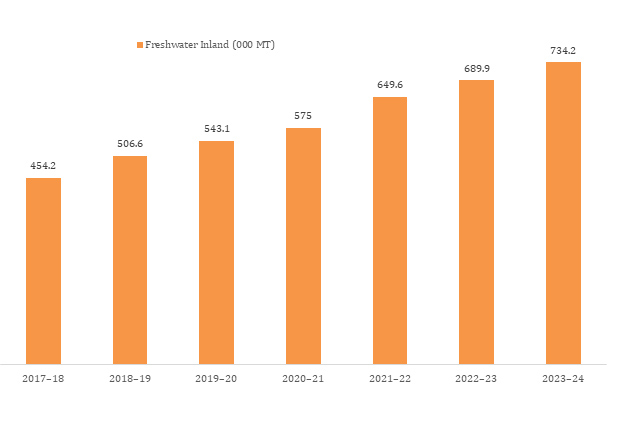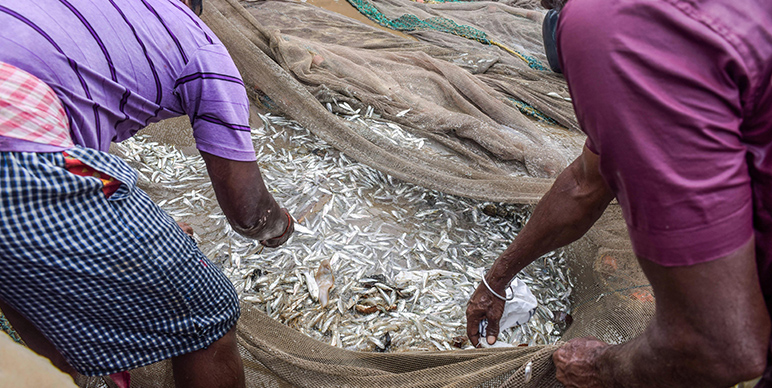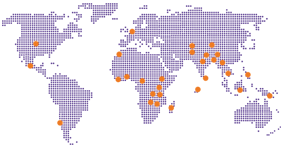Unlocking the Potential of Freshwater Fisheries in Odisha- A Blog by Natural Resource Management Team at Intellecap
How institutional reform, smart investments, and grassroots innovation can transform aquaculture in eastern India
Odisha, a coastal state in eastern India, is witnessing a quiet transformation in its fisheries sector. With over 7.1 lakh hectares of freshwater resources, 4.2 lakh hectares of brackish water, a 575-km coastline, and iconic wetlands such as Chilika Lake and Bhitarkanika, Odisha is naturally endowed for aquaculture-led growth. Between FY 2019 to FY 2024, fish production in the state surged from 8.2 lakh metric tons to 11.2 lakh metric tons. At the same time, fish imports declined by nearly 28 percent, while exports increased from 2,100 to 3,000 metric tons.
Behind this growth lies a broader shift toward freshwater fisheries, now accounting for over two-thirds of the state’s total fish output. However, these gains conceal underlying structural constraints that still impede long-term productivity, and sustainability.

A Sector with Promise- But Also Gaps
Despite ranking fifth nationally in inland fish production, Odisha’s inland fish productivity- at 0.57 tons per hectare- lags behind the national average (1.07 t/ha) and states such as Andhra Pradesh (5.40 t/ha) and Haryana (7.25 t/ha). At the same time, per capita fish consumption in the state (17.73 kg/year) is nearly three times the national average and well above the ICMR’s recommended 12 kg. Still, the sector contributes only 2.1 percent to the state’s Gross Value Added (GVA).
A closer look reveals why. Odisha’s inland fisheries remain hindered by under-resourced extension systems, limited seed supply chains, and post-harvest infrastructure. While programs such as Matasya Pokhari Yojana (MPY), biofloc systems, and GP-tank leasing have expanded access, the proliferation of overlapping interventions has increased the operational burden on the Directorate of Fisheries. The deployment of Genetically Improved Farmed Tilapia (GIFT) in reservoirs and ponds has yielded short-term gains but at ecological cost, threatening native biodiversity. Recent study by Intellecap, report
low stocking densities in small to medium reservoirs and insufficiently equipped Primary Fishermen Cooperative Societies (PFCS) with the necessary tools and skills. Many PFCS still lack basic gear, such as nets, boats, safety equipment, while the already stretched Fisheries Department struggles to provide oversight across scores of these water bodies.
Post-harvest bottlenecks further limit value addition. Cold chains, processing units, and hygienic markets remain concentrated in a few locations, leaving smallholders dependent on middlemen or forced to sell at low margins, even though consumers are willing to pay 20 percent more for processed fish. Small-scale producers face high input costs, market volatility, and regulatory hurdles- such as restrictions on borewell usage for pond renovation.
Policy Evolution
The state’s policy framework recognised the structural gaps, evident in the targeted reforms- anchored in the 2015 Fisheries Policy. It aimed to transform fisheries from a modest rural activity into a significant growth driver. Annual output increased from 2,60,000 Tonnes in 2000-01 to 991 000 Tonnes in 2021-22, sector value expanded ten-fold, and value of marine exports reached INR 4,526 crore. Supported by technical collaboration with International Institutions such as World Fish, Directorate of Fisheries carried out strategic investments in modern hatcheries, government farm upgrades, extension services to department staff as well as beneficiaries of several schemes, lifting over 1,50,000 people out of poverty, signalling the positive impact of an interventionist approach. The statewide seed-grower network, set up during the technical collaboration, has helped to streamline seed transactions and equipped District Fisheries Offices to provide precise, timely guidance to fish farmers.
The Odisha Fisheries Master Plan 2030 now sets the next horizon. Backed by an investment need of INR 34,000 crore, it seeks to double the output to just over 2 million tonnes, raise domestic sales to INR 82,000 crore, boost exports to INR 20,884 crore, lift per-capita fish intake to 22 kg and create 5.6 lakh new jobs by 2030-31. This roadmap centres on five pillars: large-scale inland aquaculture expansion through ponds, cages and 50,000 biofloc tanks; bio secure brackish-water shrimp and finfish farming for export; science-based rebuilding of marine stocks and modernised PFCSs; stronger nutrition and value-chain links, including “Product Odisha” branding; and improved governance, skills and digital services.
Building on this momentum, the state launched the INR 2,239 crore Mukhyamantri Maschyajibi Kalyan Yojana (MMKY) in FY 2024-25. Aiming to benefit over 7 lakh women SHGs and over 6 lakh fishers, with 17 sub schemes, MMKY is a crucial policy pivot. The scheme promotes GP tank leasing to Women Self-Help Groups (SHGs), cage culture in reservoirs, early-breeding programs, and wider adoption of GIFT. It also seeks to revitalize PFCS, enhance infrastructure, and expand export linkages to the USA, EU, and ASEAN. Complementary reforms such as group insurance, Fish Farmer Producer Organizations (FPOs), and targeted subsidies are also proposed.
These measures have certainly helped fisheries’ share in Odisha’s allied agricultural GVA rise from 6.3 percent in 2012-13 to 11 percent in 2024-25. Looking further ahead, the Odisha Master Plan for Fisheries Development 2030 envisions culture-based reservoir fisheries, decentralized seed networks,
and strengthened last-mile service delivery. Yet this ambitious vision hinges on execution, and the ability to embed reforms at multiple levels.
A Blueprint for Transformation
Following institutional and policy innovations are recommended as the pathway to further reforms in the sector.
- Strengthening Institutional Capacity for Coordinated Implementation
Odisha may consider setting up a multi-year Technical Coordination Unit within the Directorate of Fisheries to keep the implementation of its diverse schemes aligned with the Fisheries Master Plan 2030. Such a unit could harmonise state and central programmes, upgrade skills by strengthening the OUAT Fisheries College and diagnostic labs, and organise ongoing training for officials, entrepreneurs and Self-Help Groups. It could also break the Master Plan’s goals of increasing production output and boosting exports- into phased work plans with clear milestones. by embedding feedback loops for women and small producers- the unit could step in whenever manpower shortages arise, providing the real-time coordination and data the Department needs to implement Odisha’s fisheries agenda efficiently and equitably.
- Enhance Financial Resilience for Sustainable Aquaculture Development in Odisha.
Financial innovation is crucial to unlock investment for aquaculture entrepreneurs, particularly among Women Self-Help Groups (WSHGs). The current financial landscape in Odisha’s fisheries sector is limited by reliance on intermediaries and limited access to formal credit.
The state may consider:
- Digitisation of the existing group-based loan programmes so that applications, approvals, and repayments are fast, transparent, and large enough to keep small fishers and farmers from turning to high-cost moneylenders. Banks could also extend direct credit to village-level fisher cooperatives and women’s self-help groups, supported by simple revolving funds that ensure cash is on hand when inputs are due. At the same time, accredited feed and seed suppliers could offer secure, input-linked micro-loans under clear licensing rules. Together, these measures would expand formal credit access.
- Promotion of tailored insurance products to cover critical risks such as cyclone and climate-related losses, as well as damages to fishponds, standing crops, and equipment. Odisha’s coastal regions are highly vulnerable to natural calamities. Incentivize insurance providers through government support to offer such coverage, including for fish seed farms and fish culture
- Low-interest microfinance backed by SHG federations for essential needs like pond renovation, feed, and gear. Revolving funds for fisher groups and WSHGs could be established at a village cluster level to enhance access and reduce middleman dependency, building on past initiatives.
- Refining and rationalisation of aquaculture subsidies by updating per-hectare cost norms to reflect field realities and shifting to a dynamic, region-indexed framework that adjusts with input-price fluctuations; this will keep incentives for intensive systems (feed, hatcheries, equipment) meaningful while directing higher support to lower-income farmers who need it most.
Infrastructure investments – such as hatcheries, cold-storage, and processing units – are critical for boosting production and value addition. These could be done with the support of Public-Private Partnership (PPP) models that share risks and align incentives. PPP approach has already seen success in areas like cage culture development (Hirakud Dam). Furthermore, digital tools providing real-time information on supply shortages, prices, and credit systems can support these innovations and improve market linkages
- Improve Market Access, Transparency, and Value Chain Linkages for Odisha’s Aquaculture and Fisheries Products.
The state may consider developing simple mobile apps that give fishers real-time updates on prices, supply gaps, and available buyers; e-auctions at landing sites to ensure transparent sales and online platforms that let producers reach customers beyond local middlemen, are few other suggested steps. A suite of mobile apps and landing-site e-auctions would broadcast daily prices, input availability, and weather risks, giving Primary Fishermen Co-operative Societies and women’s self-help groups the same market intelligence as traders. Large-scale capacity building on usage of these platforms would equip producers to use these tools for finance, sales, and risk management. These platforms may also be used in issuing cyclone and weather alerts, while protecting livelihoods against extreme-weather shocks.
Furthermore, value chain can be upgraded by investing in cold-chain links, such as insulated trucks, mobile vending vans, and storage, to keep fish fresh over long distances; modernising rural and urban markets so they are clean, well lit, and women-friendly; building an integrated road-to-market network that moves harvests quickly from farm clusters to wholesale hubs; improving harbours and landing sites to international hygiene standards; and expanding the processing plants so Odisha’s shrimp, tilapia and pangasius meet export traceability rules.
Additionally, small scale producers’ skills can be upgraded by offering regular training in best management practices, finance, and entrepreneurship through Women’s SHGs, fisher co-ops. Mirroring the successful ‘Pashu Sakhi’ model in livestock, a cadre of ‘Matsya Sakhis’ can serve as village-level aquaculture agents. Covering clusters of villages, they would offer on-farm demonstrations, technical training, and market access support, thereby boosting gender-inclusive outreach and knowledge transfer.
Way Forward
Odisha has begun to lay the foundations for an innovative market ecosystem; however, these efforts remain at a nascent stage than those of the leading aquaculture states. Closing this gap will depend on moving beyond the pilot stage to major production clusters. Its inland fisheries have the potential to be a driver of rural employment, women’s empowerment, and climate-resilient livelihoods. Realizing this potential requires more than schemes and subsidies; it calls for systemic reforms and localized innovation.
This blog has been published by the Natural Resource Consulting Team at Intellecap. To know more about their work, write to marketing@intellecap.net





